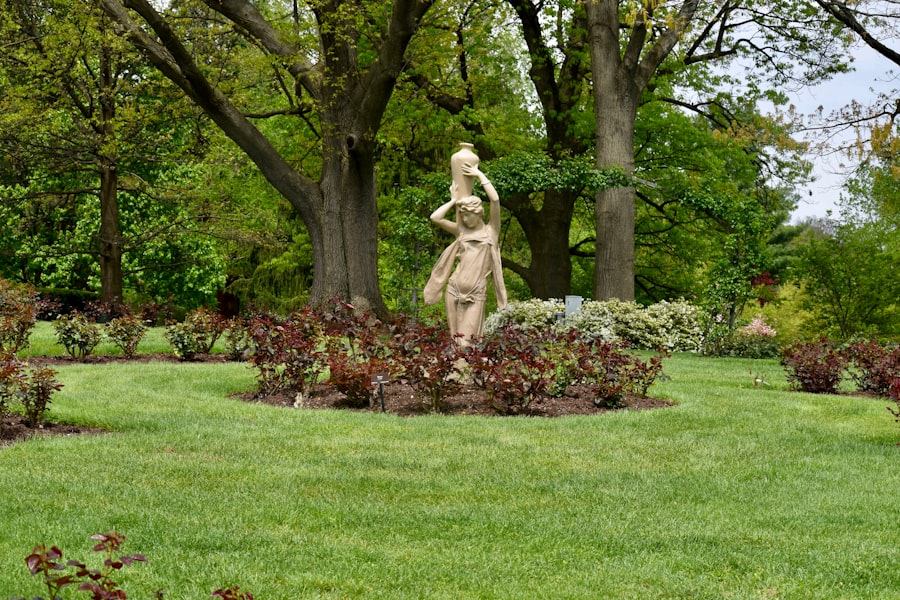Top Autumn Fertilizers for Lush Green Grass

As the summer comes to an end and the cooler temperatures of autumn set in, it’s important to give your grass the nutrients it needs to stay healthy and vibrant. Fertilizing in autumn is crucial for maintaining the overall health of your lawn and preparing it for the harsh winter months ahead. In this article, we will explore the benefits of using fertilizers in autumn, discuss the nutrient needs of grass during this season, and provide recommendations for the top organic and synthetic fertilizers to use. Additionally, we will cover best practices for applying fertilizers and common mistakes to avoid.
Key Takeaways
- Autumn fertilizers are important for maintaining healthy grass during the colder months.
- Grass has different nutrient needs in autumn than in other seasons, requiring more potassium and less nitrogen.
- Using fertilizers in autumn can improve root growth, disease resistance, and overall lawn health.
- When choosing autumn fertilizers, consider factors such as soil type, grass type, and climate.
- Top organic fertilizers for autumn include compost, bone meal, and seaweed extract, while top synthetic fertilizers include Scotts Turf Builder and Miracle-Gro.
Understanding the Nutrient Needs of Grass in Autumn
During autumn, grass has specific nutrient needs that are different from other seasons. The three main nutrients that grass requires are nitrogen, phosphorus, and potassium. Nitrogen is essential for promoting healthy leaf growth and vibrant green color. Phosphorus aids in root development and overall plant strength. Potassium helps grass withstand stressors such as cold temperatures and disease.
These nutrients are important during autumn because they help prepare the grass for winter dormancy. By providing the necessary nutrients, you are ensuring that your grass has the strength to survive the colder months and bounce back in the spring. Additionally, a well-nourished lawn is less susceptible to diseases and pests.
Benefits of Using Fertilizers in Autumn
Fertilizing in autumn offers several benefits for your grass. Firstly, it promotes root growth. As the temperatures cool down, grass focuses its energy on developing strong roots rather than leaf growth. By providing the necessary nutrients through fertilization, you are giving your grass a head start in establishing a strong root system.
Secondly, fertilizing in autumn helps with nutrient storage. Grass stores nutrients in its roots during winter dormancy to use when it starts growing again in spring. By fertilizing in autumn, you are ensuring that your grass has an ample supply of nutrients to draw from during the dormant period.
Lastly, fertilizing in autumn can improve the overall health and appearance of your grass. A well-nourished lawn is more resistant to diseases, pests, and weeds. It also has a better chance of recovering from any damage caused by summer stressors such as heat and drought.
Factors to Consider When Choosing Autumn Fertilizers
| Factors to Consider When Choosing Autumn Fertilizers | Description |
|---|---|
| Nutrient Content | Check the fertilizer label for the amount of nitrogen, phosphorus, and potassium it contains. Choose a fertilizer with a higher percentage of potassium for autumn application. |
| Soil pH | Test your soil pH before choosing a fertilizer. If your soil is acidic, choose a fertilizer with a higher pH. If your soil is alkaline, choose a fertilizer with a lower pH. |
| Application Method | Choose a fertilizer that is easy to apply and suits your needs. Granular fertilizers are easy to apply and can be spread evenly. Liquid fertilizers are fast-acting and can be applied with a sprayer. |
| Weather Conditions | Consider the weather conditions when choosing a fertilizer. Avoid applying fertilizer during heavy rain or drought. Choose a slow-release fertilizer for cooler temperatures. |
| Plant Type | Choose a fertilizer that is suitable for the type of plants you have. Different plants have different nutrient requirements. For example, trees and shrubs require a fertilizer with a higher percentage of phosphorus. |
When choosing fertilizers for autumn, there are several factors to consider. Firstly, you need to determine the nutrient ratio that your grass requires. This can be determined through a soil test or by consulting with a professional. Different grass types have different nutrient needs, so it’s important to choose a fertilizer that matches those requirements.
Secondly, consider the release rate of the fertilizer. Slow-release fertilizers are ideal for autumn because they provide a steady supply of nutrients over an extended period of time. This ensures that your grass is receiving a consistent amount of nutrients throughout the season.
Lastly, consider the organic or synthetic nature of the fertilizer. Organic fertilizers are derived from natural sources and are generally considered more environmentally friendly. They release nutrients slowly and improve soil health over time. Synthetic fertilizers, on the other hand, are made from chemical compounds and provide a quick release of nutrients. They are often more affordable but can have negative impacts on the environment if not used properly.
Top 5 Organic Fertilizers for Autumn
1. Compost: Compost is a natural and nutrient-rich fertilizer that improves soil structure and fertility. It releases nutrients slowly over time and helps retain moisture in the soil.
2. Bone Meal: Bone meal is high in phosphorus and is beneficial for root development. It is derived from animal bones and provides a slow release of nutrients.
3. Blood Meal: Blood meal is high in nitrogen and promotes healthy leaf growth. It is derived from dried animal blood and releases nutrients quickly.
4. Fish Emulsion: Fish emulsion is a liquid fertilizer made from fish waste. It is high in nitrogen and provides a quick release of nutrients.
5. Seaweed Extract: Seaweed extract is rich in trace minerals and promotes overall plant health. It can be applied as a foliar spray or added to the soil.
Top 5 Synthetic Fertilizers for Autumn

1. 10-10-10: This balanced fertilizer contains equal amounts of nitrogen, phosphorus, and potassium. It provides a quick release of nutrients and is suitable for most grass types.
2. 20-10-10: This high-nitrogen fertilizer is ideal for promoting leaf growth. It provides a quick release of nutrients and is suitable for grasses that require more nitrogen.
3. 15-0-15: This fertilizer is high in potassium and helps grass withstand stressors such as cold temperatures and disease. It provides a slow release of nutrients.
4. 18-24-6: This fertilizer is high in phosphorus and promotes root development. It provides a quick release of nutrients and is beneficial for establishing new lawns or repairing damaged areas.
5. 29-0-3: This high-nitrogen fertilizer is ideal for promoting leaf growth and overall green color. It provides a quick release of nutrients and is suitable for grasses that require more nitrogen.
How to Apply Fertilizers in Autumn for Best Results
When applying fertilizers in autumn, it’s important to follow best practices to ensure the best results. Firstly, make sure to read and follow the instructions on the fertilizer packaging. Different fertilizers have different application rates, so it’s important to apply the correct amount.
Secondly, apply the fertilizer evenly across your lawn using a spreader. This will ensure that all areas receive an equal amount of nutrients. Avoid applying too much fertilizer in one area, as this can lead to uneven growth and potential burn.
Lastly, water your lawn after applying the fertilizer. This will help activate the nutrients and ensure that they are absorbed by the grass roots. Watering also helps prevent fertilizer burn and distributes the nutrients evenly throughout the soil.
Common Mistakes to Avoid When Fertilizing Grass in Autumn
There are several common mistakes that people make when fertilizing grass in autumn. Firstly, avoid applying fertilizer too late in the season. It’s best to fertilize in early to mid-autumn to give your grass enough time to absorb the nutrients before winter dormancy.
Secondly, avoid over-fertilizing. Applying too much fertilizer can lead to excessive growth, weak roots, and increased susceptibility to diseases and pests. Follow the recommended application rates and avoid the temptation to apply more than necessary.
Lastly, avoid applying fertilizer to wet or frozen soil. This can lead to nutrient runoff and waste. Wait for the soil to dry out before applying fertilizer, and avoid fertilizing if there is a chance of rain within 24 hours.
Tips for Maintaining Lush Green Grass in Autumn
To maintain lush green grass in autumn, there are several tips you can follow. Firstly, continue mowing your lawn regularly until it stops growing. This will help prevent the grass from becoming too long and prone to disease.
Secondly, remove fallen leaves from your lawn regularly. Leaves can smother the grass and prevent sunlight from reaching it. Use a rake or leaf blower to clear away leaves and keep your lawn healthy.
Thirdly, aerate your lawn if necessary. Compacted soil can prevent water and nutrients from reaching the grass roots. Aeration helps loosen the soil and improve its overall health.
Lastly, continue watering your lawn as needed. Even though temperatures are cooler in autumn, grass still requires water to stay healthy. Water deeply but infrequently to encourage deep root growth.
Choosing the Right Fertilizer for Your Grass in Autumn
In conclusion, fertilizing in autumn is crucial for maintaining the health and appearance of your grass. By understanding the nutrient needs of grass during this season and choosing the right fertilizer, you can ensure that your lawn is well-nourished and prepared for winter dormancy. Whether you choose organic or synthetic fertilizers, following best practices for application and avoiding common mistakes will help you achieve the best results. By implementing these tips and maintaining proper lawn care practices, you can enjoy a lush green lawn throughout autumn and beyond.
Looking for the best fertilizer for your grass this autumn? Look no further! Lawn World has got you covered with their comprehensive guide on choosing the right fertilizer for your lawn during the fall season. In their article, “The Ultimate Guide to Finding the Best Fertilizer for Grass in Autumn,” they provide valuable insights and recommendations to help you achieve a lush and healthy lawn. Whether you have warm-season or cool-season grass, Lawn World’s expertise will ensure you make the right choice. Check out their website at www.lawnworld.com to access this informative article and explore their other helpful resources on lawn care. Don’t forget to visit their sitemap at www.lawnworld.com/sitemap.html for easy navigation through their content.
FAQs
What is the best time to fertilize grass in autumn?
The best time to fertilize grass in autumn is during the early part of the season, around mid-September to early October.
What nutrients should be present in a fertilizer for grass in autumn?
A fertilizer for grass in autumn should have a higher concentration of potassium and phosphorus, and a lower concentration of nitrogen.
What is the importance of potassium in a fertilizer for grass in autumn?
Potassium helps grass to develop strong roots and improve its resistance to cold weather and diseases during the winter season.
What is the importance of phosphorus in a fertilizer for grass in autumn?
Phosphorus helps grass to develop strong roots and improve its ability to absorb nutrients from the soil, which is important for its overall health and growth.
What is the recommended application rate for a fertilizer for grass in autumn?
The recommended application rate for a fertilizer for grass in autumn is 1 pound of nitrogen per 1,000 square feet of lawn.
Can I use the same fertilizer for grass in autumn as I do in spring?
No, it is not recommended to use the same fertilizer for grass in autumn as you do in spring. The nutrient requirements of grass change with the seasons, and a fertilizer that is suitable for spring may not be suitable for autumn.



